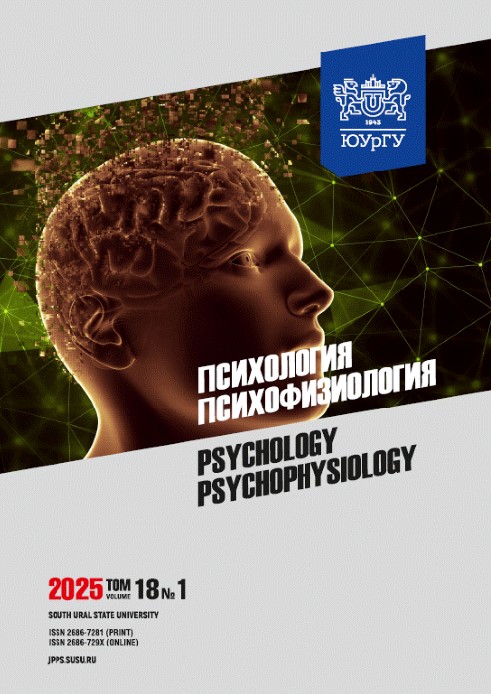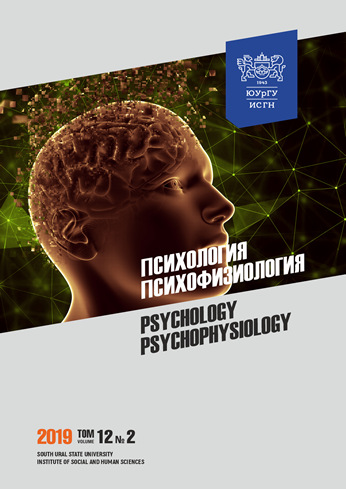Psychophysiological correlates of occupational health in teachers over the academic year
Abstract
Introduction. This study investigates the psychophysiological and mental states, as well as cardiovascular function, of teachers working under the challenging environmental conditions of the Far North, which impact their functional systems and overall occupational health. The findings aim to identify strategies for mitigating occupational health risks and enhancing the quality of life for teachers. Aim: to examine psychophysiological and hemodynamic parameters and their associations with psychological characteristics in teachers over the academic year. Materials and methods. The study comprised 43 teachers from N.K. Krupskaya Lyceum No. 1 in Magadan, with a mean age of 44.0 ± 1.8 years. Assessments were performed at two time points: at the end of the academic year and following summer vacation at the beginning of the subsequent academic year. Standardized psychological assessments were used, and psychophysiological metrics were measured using the NS-PsychoTest system (Neurosoft, Ivanovo). The Kerdo index was computed to evaluate autonomic regulation. Statistical analyses were performed using the Statistica 10.0 software package. Results. Post-vacation data revealed a statistically significant improvement in psychological well-being among teachers, albeit within moderate ranges. Systolic blood pressure values remained within optimal to normal thresholds. However, a consistently low functional status, marked by pronounced weakness and nervous inertia, was observed irrespective of the academic period. Significant correlations were identified between psychological well-being, psychophysiological and hemodynamic indicators, and measures of emotional burnout, anxiety, and neuropsychic stability. Conclusion. Summer vacations provide only partial restoration of psychophysiological resources for in the Far North. The capacity of educators to effectively manage professional challenges and emotional stress is closely linked to their psychological well-being, individual nervous system characteristics, autonomic regulation, and cardiovascular function
Downloads
References
2. Antipova E.I., Shibkova D.Z. Social workers professional potential: Psychophysiological and social criteria. Science for Education Today. 2020;10(1):191–203. (in Russ.). DOI: 10.15293/26586762.2001.11
3. Deligkaris P., Panagopoulou E., Montgomery A.J., Masoura E. Job burnout and cognitive functioning: A systematic review. Work and Stress. 2014;28(2):107–123. DOI: 10.1080/02678373.2014.909545
4. Toker S., Melamed S. Stress, recovery, sleep, and burnout. The handbook of stress and health: A guide to research and practice. Eds. C.L. Cooper, J.C. Quick. 2017;168–185. DOI: 10.1002/9781118993811.ch10.
5. Boiko V.V. Energiya emocii [Emotion energy]. St. Petersburg: Piter Publ. 2004:474. (in Russ.).
6. Schaufeli W.B., Leiter M.P., Maslach C. Burnout: 35 years of research and practice. Career Development International. 2009;14(3):204–220. DOI: 10.1108/13620430910966406
7. Hillhouse J.J., Adler C.M., Walters D.N. A simple model of stress, burnout and symptomatology in medical residents: A longitudinal study. Psychology, Health and Medicine. 2000;5:63–73. DOI: 10.1080/135485000106016
8. Grossi G., Perski A., Evengård B. et al. Physiological correlates of burnout among women. Journal of psychosomatic research. 2003;55(4):309–316. DOI: 10.1016/s0022-3999(02)00633-5
9. Kim H., Ji J., Kao D. Burnout and physical health among social workers: A three-year lon-gitudinal study. Social Work. 2011;56(3):258–268. DOI: 10.1093/sw/56.3.258
10. Bauer J., Stamm A., Virnich K. et al. Correlation between burnout syndrome and psychological and psychosomatic symptoms among teachers. International Archives of Occupational and Environmental Health. 2006;79:199–204. DOI: 10.1007/s00420-005-0050-y
11. Sonnentag S. Burnout and functioning of the hypothalamus-pituitary-adrenal-axis – there are no simple answers. Scandinavian Journal of Work, Environment and Health. 2006;32:333–337. DOI: 10.5271/sjweh.1028
12. Melamed S., Shirom A., Toker S. et al. Burnout and risk of cardiovascular disease: evidence, possible causal paths, and promising research directions. Psychological Bulletin. 2006;132(3):327–353. DOI: 10.1037/0033-2909.132.3.327
13. Harding S., Morris R., Gunnell D. et al. Is teachers mental health and wellbeing associated with students mental health and wellbeing? Journal of affective disorders. 2019;242:180–187. DOI: 10.1016/j.jad.2018.08.080
14. McEwen B.S. Stress, adaptation, and disease. Allostasis and allostatic load. Annals of the New York Academy of Sciences. 1998;840:33–44. DOI: 10.1111/j.1749-6632.1998.tb09546.x
15. Ganster D.C., Rosen C.C. Work stress and employee health: A multidisciplinary review. Journal of Management. 2013;39(5):1085–1112. DOI: 10.1177/0149206313475815
16. Bellingrath S., Weigl T., Kudielka B. Chronic work stress and exhaustion is associated with higher allostatic load in female school teachers. Stress. 2009;12(1):37–48. DOI: 10.1080/10253890802042041
17. Poulin J., Walter С. Social worker burnout: A longitidinal study. Social Work Research and Abstracts. 1993;29 (4): 5–11. DOI: 10.1093/swra/29.4.5
18. Westman M., Hobfoll S.E., Chen S. et al. Organizational stress through the lens of conservation of resources (COR) theory. Ed. Perrewe P.L., Ganster D.C. Exploring Interpersonal Dynamics (Research in Occupational Stress and Well Being, Emerald Group Publ. Ltd, Leeds. 2004;4:167–220. DOI: 10.1016/S1479-3555(04)04005-3
19. de Bloom J., Geurts S.A., Kompier M.A. Effects of short vacations, vacation activities and experiences on employee health and well-being. Stress and Health. 2012;28(4):305–318. DOI: 10.1002/smi.1434
20. Marić N., Mandić-Rajčević S., Maksimović N., Bulat P. Factors Associated with Burnout Syndrome in Primary and Secondary School Teachers in the Republic of Srpska (Bosnia and Her-zegovina). International Journal of Environmental Research and Public Health. 2020;17(10):3595. DOI: 10.3390/ijerph17103595
21. Bartosh T.P., Bartosh O.P. Manifestation of the syndrome of emotional burnout at teachers in different periods of the educational year. Gigiena i sanitaria = Hygiene and Sanitation. 2019;98(4):411–417. (in Russ.). DOI: 10.18821/0016-9900-2019-98-4-411-417
22. Bartosh T.P., Bartosh O.P. The psychophysiological status and personality traits in teachers of the Magadan region. Gigiena i sanitaria = Hygiene and Sanitation. 2010;3:42–46. (in Russ.).
23. Mantrova I.N. Metodicheskoe rukovodstvo po psikhofiziologicheskoi i psikhologicheskoi diagnostike [Methodological guide to psychophysiological and psychological diagnostics]. Ivanovo: Neirosoft Publ. 2007:216. (in Russ.).
24. Shkaly, testy i oprosniki v medicinskoi reabilitacii [Scales, tests and questionnaires in medical rehabilitation]. Ed. A.N. Belovoi, O.N. Shhepetovoi. Moscow: Antidor Publ. 2002:99. (in Russ.).
25. Dupuy H.J. The Psychological general Well-Being (PGWB) Index. Assessment of Quality of Life in clinical trials of cardiovascular therapies / Ed. N. Wenger. New York: Le Jacq. 1990;9:170–183.
26. Ivanov S.A., Nevzorova E.V., Gulin A.V. Kolichestvennaya otsenka funktsionalnykh vozmozhnostey serdechno-sosudistoy sistemy [Quantitative evaluation of functional capability of cardio-vascular system]. Vestnik Tambovskogo universiteta. Seriya Estestvennye i tekhnicheskie nauki = Tambov University Reports. Series: Natural and Technical Sciences. 2017;22(6):1535–1540. (in Russ.). DOI: 10.20310/1810-0198-2017-22-6-1535-1540
27. Davidson O.B., Eden D., Westman M. et al. Sabbatical leave: Who gains and how much? Journal of Applied Psychology. 2010;95:953–964. DOI: 10.1037/a0020068
28. Troshikhina E.G., Manukyan V.R. Anxiety and stable emotional states in the structure of psycho-emotional wellbeing. Vestnik SPbGU. Psikhologiya i pedagogika = Vestnik SPbSU. Psychology and Education. 2017;7(3):211–223. (in Russ.). DOI: 10.21638/11701/spbu16.2017.302
29. Shibkova D.Z., Efimova N.V., Shevtsov A.V. Criteria for assessing the psychophysiological adaptation of schoolchildren from different regions of Russia to the the educational environment. Psikhologiya. Psikhofiziologiya = Psychology. Psychophysiology. 2024;17(2):100–116. (in Russ.). DOI: 10.14529/jpps240209
30. Ushakov A.V., Ivanchenko V.S., Gagarina A.A. Pathogenic mechanisms of arterial hypertension in patients with chronic psychoemotional stress. Arterialnaya gipertenziya = Arterial Hypertension. 2016;22(2):128–143.(in Russ.). DOI: 10.18705/1607-419X-2016-22-2-128-143.
31. Geurts S.A.E., Sonnentag S. Recovery as an exploratory mechanism in the relation between acute stress reactions and chronic health impairment. Scandinavian Journal of Work, Environment and Health. 2006;32:482–492. DOI: 10.5271/sjweh.1053
32. Gertler J., Dale L., Tracy N. et al. Resilient, but for how long? The relationships between temperament, burnout, and mental health in healthcare workers during the Covid-19 pandemic. Frontiers in Psychiatry. 2023;14.1163579. DOI: 10.3389/fpsyt.2023.1163579
References on translit
-Copyright (c) 2025 Psychology. Psychophysiology

This work is licensed under a Creative Commons Attribution-NonCommercial-NoDerivatives 4.0 International License.



